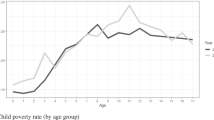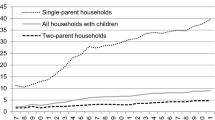Abstract
This paper analyzes the data from the Population Census of 2011 to identify the characteristics of poor ethnic minority groups in Hong Kong and the factors that are associated with child poverty among these ethnic minorities. The results show that the child poverty level varies between different ethnic groups and that ethnic minorities from developing nations are likely to have a higher poverty level. In particular, Pakistani children have the highest poverty rate among all ethnic groups. The results also show that Pakistani, Nepalese, and Mixed (Chinese and Asian) nationalities have a higher child poverty rate than that of Chinese individuals who constitute the majority of the Hong Kong population. The main reason for this is that, unlike their Chinese counterparts, some of these ethnic minority households have not benefited from their own human capital or their length of exposure in the local society in Hong Kong. And even if they have benefited, the positive impact of these factors on ethnic minority households was much weaker compared to that of Chinese households. These results suggest that ethnic minorities need to be categorized as a separate group in order to assess their specific needs, and assimilation policies, especially support on Chinese language learning, need to be an integral part of the government’s poverty reduction strategy to reduce child poverty among ethnic minorities.
Similar content being viewed by others
References
Alba, R., & Nee, V. (1997). Rethinking assimilation theory for a new era of immigration. International Migration Review, 31(4), 826–874.
Becker, G. S. (1962). Investment in human capital: A theoretical analysis. The Journal of Political Economy, 70(5), 9–49.
Becker, G. S. (2007). Health as human capital: Synthesis and extensions. Oxford Economic Papers, 59(3), 379–410.
Census and Statistics Department. (2012). Thematic report: Ethnic minorities. Hong Kong: Census and Statistics Department.
Cheung, K. C. K. (2015). Child poverty in Hong Kong single-parent families. Child Indicators Research, 8(3), 517–536.
Chiswick, B. R., & Miller, P. W. (1995). The endogeneity between language and earnings: International analyses. Journal of Labor Economics, 13(2), 246–288.
Chou, K. L. (2013). Familial effect on child poverty in Hong Kong immigrant families. Social Indicators Research, 113(1), 183–195.
Chou, K. L., Cheung, K. C. K., Lau, M. K. W., & Sin, T. C. H. (2014). Trends in child poverty in Hong Kong immigrant families. Social Indicators Research, 117(3), 811–825.
Chou, K. L., & Chow, N. W. S. (2009). The roles of human capital and social capital in the economic integration of new arrivals from Mainland China to Hong Kong. Habitat International, 33(4), 340–346.
Commission on Poverty. (2013). Press release: CE chairs first Commission on Poverty Summit, 28 September 2013. http://www.info.gov.hk/gia/general/201309/28/P201309280453.htm.
Crabtree, S. A., & Wong, H. (2013). ‘Ah Cha’! The racial discrimination of Pakistani minority communities in Hong Kong: An analysis of multiple, intersecting oppressions. British Journal of Social Work, 43(5), 945–963.
Flores, G., Bauchner, H., Feinstein, A. R., & Nguyen, U. S. (1999). The impact of ethnicity, family income, and parental education on children’s health and use of health services. American Journal of Public Health, 89(7), 1066–1071.
Friedman, S., & Lichter, D. T. (1998). Spatial inequality and poverty among American children. Population Research and Policy Review, 17(2), 91–109.
Frost, S. (2004). Building Hong Kong: Nepalese labour in the construction sector. Journal of Contemporary Asia, 34(3), 364–376.
Gans, H. J. (1992). Second-generation decline: Scenarios for the economic and ethnic futures of the post-1965 American immigrants. Ethnic and Racial Studies, 15(2), 173–192.
Glick, J. E., & White, M. J. (2003). The academic trajectories of immigrant youths: Analysis within and across cohorts. Demography, 40(4), 759–783.
Government of the Hong Kong Special Administrative Region. (2015). Hong Kong poverty situation report 2014. Hong Kong: Government of the Hong Kong Special Administrative Region.
Haller, W., Portes, A., & Lynch, S. M. (2011). Dreams fulfilled, dreams shattered: Determinants of segmented assimilation in the second generation. Social Forces, 89(3), 733–762.
Haveman, R. (2009). What does it mean to be poor in a rich society? In M. Cancian & S. Danziger (Eds.), Changing poverty, changing policies. New York: Russell Sage Foundation.
Hernandez, D. J., & Charney, E. (1998). From generation to generation: The health and well-being of children in immigrant families. Washington: National Academies Press.
Hue, M. T., & Kennedy, K. J. (2014). Creating culturally responsive environments: Ethnic minority teachers’ constructs of cultural diversity in Hong Kong secondary schools. Asia Pacific Journal of Education, 34(3), 273–287.
Hue, M. T., Leung, C. H., & Kennedy, K. J. (2015). Student perception of assessment practices: Towards ‘no loser’classrooms for all students in the ethnic minority schools in Hong Kong. Educational Assessment, Evaluation and Accountability, 27(3), 253–273.
Kapai, P. (2015). Status of ethnic minorities in Hong Kong 1997–2014. Hong Kong: Faculty of Law, The University of Hong Kong.
Keith, V. M., & Herring, C. (1991). Skin tone and stratification in the Black community. American Journal of Sociology, 97(3), 760–778.
Kossoudji, S. A. (1988). English language ability and the labor market opportunities of Hispanic and East Asian immigrant men. Journal of Labor Economics, 6(2), 205–228.
Lai, C., Gao, F., & Wang, Q. (2015). Bicultural orientation and Chinese language learning among South Asian ethnic minority students in Hong Kong. International Journal of Bilingual Education and Bilingualism, 18(2), 203–224.
Law, K. Y., & Lee, K. M. (2013). Socio-political embeddings of South Asian ethnic minorities’ economic situations in Hong Kong. Journal of Contemporary China, 22(84), 984–1005.
Lee, K. M., & Law, K. Y. (2014). Colonialism, sinicization and ethnic minorities in Hong Kong. In N. Vasu, Y. Chin, & K. Y. Law (Eds.), Nations, national narratives and communities in the Asia-Pacific (pp. 111–141). London: Routledge.
Lee, D., & Li, M. (2011). Being young and a minority: A study of the challenges encountered by young ethnic minorities in Hong Kong. Journal of Youth Studies, 14(2), 42–53.
Lee, K. M., Wong, H., & Law, K. Y. (2007). Social polarisation and poverty in the global city: The case of Hong Kong. China Report, 43(1), 1–30.
Lichter, D. T. (1997). Poverty and inequality among children. Annual Review of Sociology, 23, 121–145.
Lichter, D. T., Qian, Z., & Crowley, M. L. (2005). Child poverty among racial minorities and immigrants: Explaining trends and differentials. Social Science Quarterly, 86(s1), 1037–1059.
Liu, P. W., Zhang, J., & Chong, S. C. (2004). Occupational segregation and wage differentials between natives and immigrants: Evidence from Hong Kong. Journal of Development Economics, 73(1), 395–413.
Loper, K. (2004). Race and equality: A study of ethnic minorities in Hong Kong’s education system. University of Hong Kong Centre for Comparative and Public Law, Occasional Paper No. 12, 2004. http://ssrn.com/abstract=1601276.
McLanahan, S., & Sandefur, G. (1994). Growing up with a single parent: What hurts, what helps. Cambridge, MA: Harvard University Press.
Platt, L. (2002). Parallel lives? Poverty among ethnic minority groups in Britain (Vol. 107). London: Child Poverty Action Group.
Portes, A., Fernández-Kelly, P., & Haller, W. (2009). The adaptation of the immigrant second generation in America: A theoretical overview and recent evidence. Journal of Ethnic and Migration Studies, 35(7), 1077–1104.
Portes, A., & Rumbaut, R. G. (2001). Legacies: The story of the immigrant second generation. Berkeley: University of California Press.
Portes, A., & Zhou, M. (1993). The new second generation: Segmented assimilation and its variants. The Annals of the American Academy of Political and Social Science, 530(1), 74–96.
Stier, H., & Tienda, M. (2001). The color of opportunity: Pathways to family, welfare, and work. Chicago: University of Chicago Press.
Thomas, K. J. (2011). Familial influences on poverty among young children in black immigrant, US-born black, and nonblack immigrant families. Demography, 48(2), 437–460.
Tsung, L., & Gao, F. (2012). What accounts for the underachievement of South Asians in Hong Kong? The voices of Pakistani and Nepalese parents. Educational Research, 54(1), 51–63.
Yuen, Y. M. C. (2013). Ethnicity, level of study, gender, religious affiliation and life satisfaction of adolescents from diverse cultures in Hong Kong. Journal of Youth Studies, 16(6), 776–791.
Yuen, Y. M. C., & Lee, M. (2013). Mapping the life satisfaction of adolescents in Hong Kong secondary schools with high ethnic concentration. Youth and Society. doi:10.1177/0044118X13502060.
Zhang, Z., & Wu, X. (2011). Social change, cohort quality and economic adaptation of Chinese immigrants in Hong Kong, 1991–2006. Asian and Pacific Migration Journal, 20(1), 1–29.
Zhou, M. (1997). Segmented assimilation: Issues, controversies, and recent research on the new second generation. International Migration Review, 31(4), 975–1008.
Acknowledgements
This research project is funded by the Public Policy Research Funding Scheme (Reference number: 2014.A5.003.14D) of the Central Policy Unit of the Hong Kong Special Administrative Region Government.
Author information
Authors and Affiliations
Corresponding author
Rights and permissions
About this article
Cite this article
Cheung, K.CK., Chou, KL. Child Poverty Among Hong Kong Ethnic Minorities. Soc Indic Res 137, 93–112 (2018). https://doi.org/10.1007/s11205-017-1599-z
Accepted:
Published:
Issue Date:
DOI: https://doi.org/10.1007/s11205-017-1599-z




